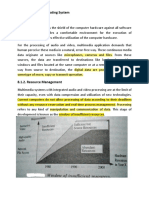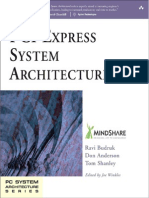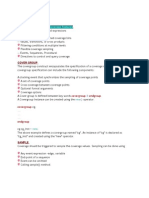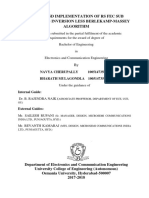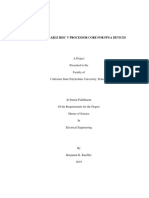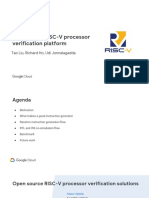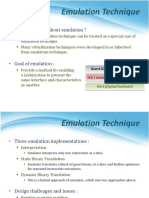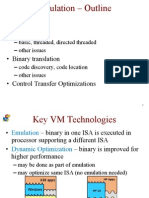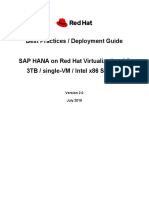VM && QEMU
Date:2010/04/09 , rednoah
�Outline
Introduction to Virtual Machine
VM
Overview Interpretation Binary Translation Process VM
Introduction to QEMU
QEMU
Overview QEMU JIT QEMU other topics
�Reference
James Smith and Ravi Nair, Virtual Machines: Versatile Platforms for Systems and Processors
QEMU internals http://wiki.qemu.org/Main_Page
�VM Overview
Why do we prefer something virtual than real?
why Virtual memory? why Java virtual machine? why Virtual I/O? why Virtual Private Network (VPN) ?
�VM Overview
Why do we prefer something virtual than real?
why Virtual memory?
sharing,
protection, large address space,
why Java virtual machine?
interoperability,
application sharing, protection
why Virtual I/O?
flexibility,
low cost sharing, better management
why Virtual Private Network (VPN) ?
secure
communication over unsecure net
�VM Overview
Common VMs:
IBM VM/CMS VMware GSX Xen Virtual PC JVM, MS CLI (Common Language Infrastructure) Dalvik virtual machine IA-32 IL, Apple Rosetta, HP PA-Aries Transmeta Crusoe QEMU
�VM Overview
Virtualization
OS: A machine
is defined
by ISA Compiler: A machine is defined by ABI (User ISA + OS calls) Application: A machine is defined by API (User ISA + Library calls)
�VM Overview
Virtual Machines
Add
virtualization software to a host platform and support guest process or system on a VM.
�VM Overview
Process Virtual Machine
Guest processes may intermingle with host processes Execute applications with an ISA different from the HW platform Couple at ABI level via runtime system As a practical matter, guest OS and host OS are often the same
Ex. FX!32 (allows x86 Win32 programs to execute on Alpha-based systems running Windows NT) Different OS: ex. Wine (Enable running Win32 program on Linux)
�VM Overview
System Virtual Machine
Provide
a system environment Constructed at ISA-level Example: IBM VM/360, Vmware Purpose:
Server consolidation Secure partitioning Fault isolation Support software development and deployment Cloud computing bandwagon
�VM Overview
High-Level Language Virtual Machine
Java and MS CIL (Common Language Infrastructure) are current examples.
Binary class files are distributed ISA (IR) is part of binary class format OS interaction via API (part of VM platform)
�VM Overview
High-Level Language Virtual Machine
Dalvik bytecode format
�VM Overview
QEMU User-mode
QEMU System-mode
�Interpretation
Emulation ? Simulation ?
Emulation: to be you. (A method for enabling a (sub)system to present the same interface and characteristics as another) Simulation: to be like you.
Guest and Host
Refer to platforms
Source and Target Source ISA: Original instruction set or binary Target ISA: Instruction set being executed by processor performing emulation.
Refer to ISAs
�Interpretation
Ways of implementing emulation
Interpretation:
instruction at-a-time Binary Translation: block-at-a-time optimized for repeated instruction executions
Why binaries/executables? Dynamic or Static compilation ?
�Interpretation
Interpretation State
Hold complete source architecture state in the interpreters data memory
target-arm/cpu.h
�Interpretation Decode-Dispatch Interpretation
while (!halt && !interrupt) { inst = code(PC); opcode = extract(inst,31,6); switch(opcode) { case LdWord: LdWord(inst); case ALU: ALU(inst); case Branch: Branch(inst); ... }
�Interpretation Decode-Dispatch Interpretation
LdWord(inst) { RT = extract (inst,25,5); RA = extract (inst,20,5); displacement =extract (inst,15,16); source = regs[RA]; address = source + displacement ; regs[RT] = data[address]; PC = PC + 4; }
�Interpretation Decode-Dispatch Interpretation
�Interpretation Decode-Dispatch (Efficiency)
�Interpretation
Compiled Emulation
Replace each source instruction by a sequence of emulation functions in high-level language. The in-lined program can then be compiled and optimized by the compiler. After redundancy elimination optimization, the generated code may be similar to the result of static translation
e.g.
add r1,r2,r3 sub r4,r5,r6
add(r1,r2,r3); sub(r4,r5,r6);
QEMU uses a similar approach.
�Binary Translation
Generate custom code for every source instruction. For example, a load instruction in source code could be translated into a respective load instruction in native code. Get rid of repeated parsing, decoding, and jumping overhead. Register mapping is needed to reduce load/stores significantly.
�Binary Translation
Example: Binary translation from IA-32 binary to PowerPC binary
�Binary Translation
�Binary Translation
Register mapping to reduce load/store
�Binary Translation
�Binary Translation
Register mapping
Easier
if Number of target registers > number of source registers. (e.g. translating x86 binary to RISC) May be on a per-block, or per-trace, or per-loop, basis If the number of target registers is not enough Infrequently used registers (Source) may not be mapped
�Binary Translation
Source PC v.s. Target PC (program counter)
TPC
(Target PC) is different from SPC (Source PC) For indirect branches, the registers hold source PCs. So we must provide a way to map SPCs to TPCs.
Incorrect translation ! /* jump indirect through ctr, but ctr contains SPC */
�Binary Translation
Dynamic Translation
First Interpret
And perform code discovery as a byproduct Incrementally, as it is discovered Place translated blocks into Code Cache Save source to target PC mapping in an Address Lookup Table Execute translated block to end Lookup next source PC in table If translated, jump to target PC else interpret and translate
Translate Code
Emulation process
��Binary Translation
The translation system needs to track SPC at all times
Control
is shifted as needed between the interpreter, the EM, and translated blocks in the code cache. Each component must have a way to track SPC.
Interpreter
uses SPC directly Interpreter passes the next SPC to EM Translated block passes the next SPC to EM using JAL (jump and link instruction) or mapping SPC to a register.
�Binary Translation
Control flows between translated block and emulation manager
Translation Block
Emulation Manager
Translation Block
Context switch
Translation Block
�Binary Translation Control flow optimization - Chaining
1
Interpreter
0 2
a.out 4
1 SPC-TPC Lookup Table
Emulator
3
Cache cache
�Binary Translation
Condition Codes (CC)
IA32, PowerPC, Sparc, VAX, and ARM all have CC MIPS, Alpha, and Itanium do not
Case 1: Both source and target machines have CC the source machines CC must be save/restored Case 2: Only source machine has CC target machine must simulate the CC some source machines set many CC in one instruction Case 3: Only target machine has CC compare & branch is emulated by two instruction Case 4: Neither target nor source have CC no issues
�Binary Translation
CC is set more often than referenced.
If a CC is set before its use, the earlier set CC does not need to be saved. However, most CC are saved at the end of each translated block. If it can be determined that the following block always set the CC before use, the current block does not save the CC it sets. The payoff is very high. (ex. all x86 ALU operations update CC)
Some rarely used CC (V,C) or flags (e.g. parity) can be simulated using lazy evaluation. Instead of saving/restoring the CC or the flag, save the instruction and its operands and re-compute the CC/flag when it is needed
�Binary Translation CC example (IA32 to PowerPC)
�Binary Translation
CC Optimizations
Combine Compare with Branch ARM may use two instructions for a branch: a compare (or a TST or TEQ) instruction followed by a branch. For some simple cases, MIPS can simply use a compare-and-branch instruction. There are cases, although very rare, the translated code (in terms of number of instructions) could be even smaller than the original ARM code.
Mapping each flag to a dedicated register Example: N:R17 Z: R18 C:R19 V:R20
This can reduce instruction overhead to extract/deposit target flags from/to the CPSR (Current Program Status Register). It the target architecture has sufficient number of registers, this optimization should be considered. Otherwise, it may take away three more registers, and cause register spilling.
�Binary Translation
Other issues of translation
Data
Formats and Arithmetic Memory Data Alignment Byte Order
�Process VM
Perform guest/host mapping at the ABI (ISA + system calls) level Encapsulate guest process in process-level runtime Example: QEMU linux usermode Issues Memory architecture Exception architecture OS call emulation Overall VM architecture High performance implementation System environments
�Process VM Implementation
�Process VM
Loader
A special loader writes guest code and data into a region holding the guests memory image, and load the runtime code into memory. Allocate memory for the code cache and other tables Initialize runtime data structures and invoke OS to establish signal handlers. Emulate guest instructions with interpreter or binary translation What translation to flush?
Initialization
Emulation engine
Code Cache Manager
OS Call Emulator
Translate OS calls and OS responses
Handle signals If registered by src, pass to src handler, If not, emulate host response Form precise state
Exception Emulator
�Process VM
Compatibility A strict definition of compatibility (e.g. bug-to-bug compatible) would exclude many useful process VM. Intrinsic compatibility
Any software written by the most devious programmer will work in a compatible way Example: Intel strives for intrinsic compatibility when it produces a new x86 microprocessor
Extrinsic compatibility Many useful VM applications do not achieve intrinsic compatibility Limited application set: run Microsoft productivity tools (Office)
�Process VM
Compatibility issues
State Mapping if the guest process uses all virtual address space, intrinsic compatibility cannot be achieved Mapping of control transfers some potential trapping instructions may be removed User-level instruction FP format may be different OS operation host OS does not support exactly the same function as the guests native OS
�Process VM
Software Memory Mapping
Runtime
Software to maintain mapping table Similar to hardware page table/TLB Slow, but always work
�Process VM
Guest address space > Host address space + Runtime
�Process VM
Direct Translation Methods
VM software mapping is slow Use underlying hardware
If guest address space + runtime fit within host space
�Process VM - Protecting Runtime Memory
�QEMU Overview
Created by Fabrice Bellard in 2003 Function-level emulation
Faster than cycle-accurate simulators. Good enough to use applications written for another CPU.
Just-in-time (JIT) compilation support to achieve high performance (400 ~ 500 MIPS) Lots of peripherals support (VGA, serial, and Ethernet, etc) Lots of target hosts and targets support (full system emulation)
x86, arm, mips, sh4, cris, sparc, powerpc, nds32, qemu/hw/* contain all of the supported boards.
Good enough to use applications written for another CPU. User mode emulation: can run applications compiled for another CPU.
�QEMU overview
Update status
0.9.1 (Jan 6, 2008) Stable and stop for a long time 0.10 (Mar 5, 2009) TCG support (a new general JIT framework) 0.11 (Sep 24, 2009) KVM support 0.12 More KVM support. Code refactoring new peripheral framework to support dynamic board configuration
�QEMU Screenshot Emulate ARM11MPCore
�QEMU Screenshot Android 2.1
�QEMU JIT
TCG (Tiny Code Generator)
a
generic backend for a C compiler. It was simplified to be used in QEMU. "basic block" corresponds to a list of instructions terminated by a branch instruction.
Translation Block (TB)
A TCG
16Mb code cache size
�QEMU JIT
Prologue, Epilogue
When the target-machine is ARM
�QEMU JIT
cpu exec() called each time around main loop. Program executes until an unchained block is encountered. Returns to cpu exec() through epilogue. Enter the code cache:
Linux: Set buffer executable and jump to Buffer & Execute
�QEMU JIT code gen flow
Front-end: qemu/tcg/tcg.c gen_intermediate_code disas_XXX_insn
Interprete source instruction and translate to micro-ops.
Translation stops when a conditional branch is encountered.
�QEMU JIT code gen flow
tcg_liveness_analysis
Remove dead code. Ex. and_i32 t0, t0, $0xffffffff Ex. add_i32 t0, t1, t2 add_i32 t0, t0, $1 mov_i32 t0, $1
�QEMU JIT code gen flow
Register mapping
register struct CPUNDS32State *env asm(r14); register target_ulong T0 asm(r15); register target_ulong T1 asm(r12); register target_ulong T2 asm(r13);
�QEMU JIT Block chaining
Avoid context-switch overhead Every time a block returns, try to chain it. tb_add_jump(): back-patch the native jump address
�QEMU JIT Memory load emulation
Base on qemu 0.10.5 , emulate mips (little endian) decode_opc translate mips-asm to micro-op Translation stops when a conditional branch is encountered. gen_store_gpr will store this value to the emulated cpus general register.
�QEMU JIT Memory load emulation
target-mips/translate.c
�QEMU JIT Memory load emulation
Generate binary code
/qemu/Translate-all.c
cpu_gen_code /qemu/Tcg/i386/tcg-target.c tcg_out_op tcg_reg_alloc_op tcg_gen_code_common gen_intermediate_code
/qemu/Tcg.c
tcg_gen_code
opc
tcg outputs 0xe8 which means a call instruction in x86. It will call the functions in array qemu_ld_helpers. The args to the functions is passed by registers EAX,EDX and ECX.
�QEMU JIT Memory load emulation
0xe8 pc (s->code_ptr)
pc+4 (s->code_ptr += 4)
#define REGPARM __attribute((regparm(3)))
Offset (4 byte) __ldb_mmu
qemu_ld_helpers[s_bits]
�QEMU JIT Memory load emulation SoftMMU
Translate guest virtual address to host virtual address.
Translate
the guest physical address to host physical
address.
qemu
needs to find the PhysPageDesc entry in table **l1_phys_map and get the phys_offset. guest_phy_addr[31:22] first level entry guest_phy_addr[21:12] second level entry If page not find cpu_register_physical_memory : qemu creates a new entry (by mmap) and updates its value and insert this entry to the l1_phys_map table.
�QEMU JIT Memory load emulation SoftMMU
Translate the guest physical address to host virtual address. phys_offset == IO_MEM_RAM guest RAM space
phys_offset[31:12]: the offset of this page in emulated physical memory. phys_offset + phys_ram_base = host virtual address
phys_offset > IO_MEM_ROM MMIO space
phys_offset[11:3]: the index in io_mem_write/io_mem_read array. register the I/O emulation functions:
�QEMU JIT Memory load emulation SoftMMU
Original way
1. Translate the guest virtual address to guest physical address 2. Then qemu needs to find the PhysPageDesc entry in table l1_phys_map and get the phys_offset 3. phys_offset + phys_ram_base = host virtual address 1. Search TLB first. 2. Hit: guest_virtual_address + addend = host_virtual_address. 3. Miss: Search the l1_phys_map table and then fill the corresponding entry to the TLB table
Software TLB table
�QEMU JIT Memory load emulation SoftMMU (__ldX_mmu)
()
�QEMU JIT Memory load emulation SoftMMU (__ldX_mmu)
cpu_exectb_find_fasttb_find_slowget_phys_addr_code(if tlb not match)ldub_code(softmmu_header.h)__ldl_mmu(softmmu_template.h)tlb _fillcpu_XXX_handle_mmu_faulttlb_set_pagetlb_set_page_exec
�QEMU JIT Summary
Look up TB
Cached? Yes Execute Code cache
No
Translate one TB
Chain it to existed TBs
Exception happen and handling
�QEMU other topics
Fixed register allocation
register struct CPUARMState *env asm(r14); register target_ulong T0 asm(r15); register target_ulong T1 asm(r12); register target_ulong T2 asm(r13);
Conditional code (CC)
Lazy
CC evaluation Recovery when needed
R=A+B
CC_SRC=A CC_DST=R CC_OP=CC_OP_ADDL
�Source code organization
qemu/ qemu-* : OS dependent API wrapper example: memory allocation or socket target-*/ : target porting tcg/ : new and unified JIT framework *-user/ : user-mode emulation on different OS softmmu-* : target MMU acceleration framework hw/ : peripheral model fpu : softfloat FPU emulation library gdb : GDB stub implementation
�Source code organization
TranslationBlock structure in translate-all.h Translation cache is code_gen_buffer in exec.c cpu-exec() in cpu-exec.c orchestrates translation and block chaining. vl.c: Main loop for system emulation.
�Sample Demo
Using gdb to debug QEMU Using QEMU to debug guest OS QEMU Linux-user mode emulation QEMU system mode emulation
�Funny issues of QEMU
Generate execution traces to drive timing models
Try
to integrate timing models
Improve optimization, say, by retaining chaining across interrupts TCG Optimization.
Code
cache management Optimization passes of micro-op
Multi-core emulate multi-core























